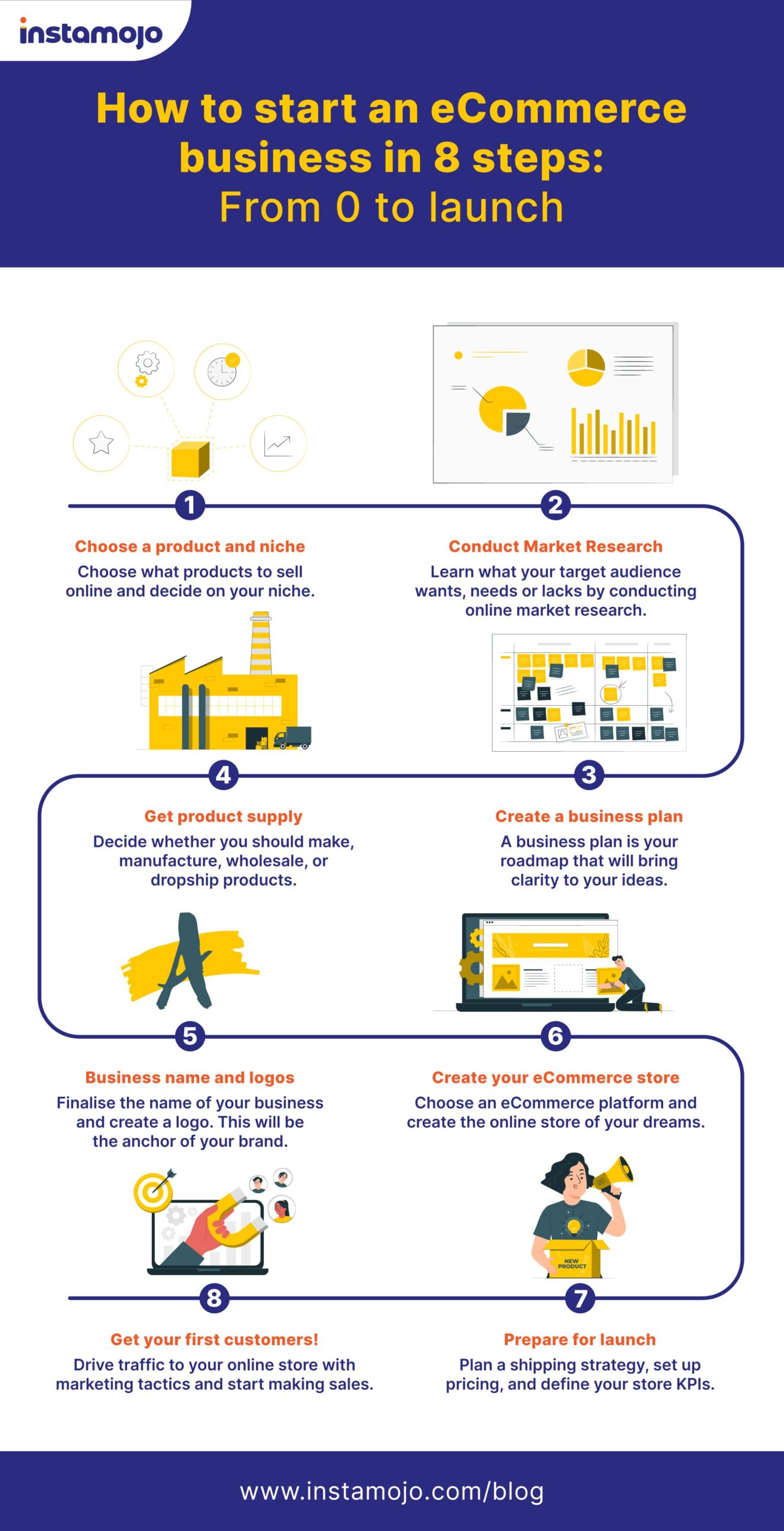You might agree to this that accessing the tools for launching an eCommerce business is easier than ever. Whether you’re transitioning from a physical store to online or starting a small home-based business, this blog provides essential guidance. Discover how to start eCommerce business in India with just 9 simple steps.
Why start an eCommerce business?
Why consider launching an online business in India? The reasons are numerous, spanning from increased profits to enhanced customer engagement.
View this post on Instagram
However, let’s focus on the top three compelling reasons to initiate an eCommerce business in 2024.
1. Wider exposure for your business
You have the scope of getting anyone as your customer, regardless of their geographic location, as long as they have an internet connection.
The pandemic accelerated the growth of eCommerce industry — more shoppers are coming online.
A survey by Engine found that people are spending on average 10-30% more online as a result of the pandemic.
2. 24/7 shop
You can make money while you sleep, literally. By automating business processes, you will have minimal work to do. You can focus on marketing and scaling your business.
3. You can start with little to no money
If the fear of high costs is holding you back from starting your eCommerce business, it’s actually more affordable than you think, despite its perceived complexity.
You can even get a free online store with Instamojo.
Let’s explore the essentials for launching and expanding your eCommerce business in India.
Is eCommerce profitable?
So, is eCommerce a moneymaker? Well, it really depends on how you play your cards. Some online businesses hit the jackpot, making good profit margins by being smart with their plans, knowing their customers, and staying on top of the game.
But, it’s not all smooth sailing – you’ve got to deal with competition and changes in what people want.
So, if you’re up for the challenge and know your stuff, eCommerce can totally be a money-spinner.
How much does it cost to start an eCommerce business in India?
Acquiring a range of products for your inventory is essential, and the associated costs will fluctuate depending on the type of products you choose.
It is advisable to allocate a minimum budget of INR 20,000 initially. Considering the diverse expenses involved, a rough estimate suggests that around INR 85,000 to INR 1 lakh is required to initiate your own eCommerce business in India.
Guess what? You can build your online store FREE with Instamojo. Whereas, you can opt for the premium pricing for more features and theme options.
How to start an eCommerce business in India?
Curious about launching a prosperous online business from the ground up? We’ll lead you through the steps you can initiate today, mirroring the success of many others.

Step 1: Determine niche & products
Choosing the right products is crucial for the success of your business. But how do you determine if your products will be profitable enough? Consider these three points before selecting a product to sell:
- Does the product solve a problem?
- How constant is the product demand?
- Is the market too saturated?
For an eCommerce business to thrive, you need to focus not just on the products, but the niche as well.
In simple words, niche is the category of products you sell and helps define your target audience.
For example, if you decide to sell kitchenware, ’coffee mugs’ is a niche. You can further divide it into sub-niches. The more you niche down, the better chances your brand has to stand out.
Different kinds of products to sell online
Wondering what to sell online? You can sell three main types of products – physical, digital, and services.
1. Physical goods
Material goods that you either need to source or manufacture are physical products. They are the most common form of products bought and sold online. You can sell anything from art and clothes to grocery and plants.
2. Digital products
The digital products are the one that could be downloaded from the internet. These include ebooks, templates, graphics and other such virtual products. Moreover, you should have knowledge on how to sell digital products online.
Step 2: Conduct market research
To determine if your business idea has enough scope to succeed and grow, you need to conduct market research. We know that the term makes it seem complicated and technical. Here’s how you can conduct a market research in easy ways:
1. Google search
Search for related products and find keywords. Check the different variants of product names and descriptions. For example, if you want to sell ‘macrame items’ online, you need to find out what they search to get those products. They search for ‘wall hangings’.
2. Competitor research
Which brands are well-known in your niche? What is their business model and marketing approach? And how does your product differ from theirs? This is what you can grab through the competitor research.
3. Define your target audience
You need to know who you’re selling to before you start selling. Define your ideal buyer and their pain points. This will help you set a perfect target audience and could assist you with the accurate strategy of niche marketing.
Step 3: Create a business plan
Before setting up the products in your online store, it is more important to set a business plan. Creating a business plan will give you clarity.
Here’s what you can put into a business plan:
- Branding
- Execution plan
- Market
- Marketing and sales
- Finance and funding
Let’s make it easy to understand. This is how you can start with a business plan:
View this post on Instagram
Step 4: Sourcing products
You have three main ways to get hold of products to start your eCommerce business. Each way has its pros and cons.
1. Make your own products
This is most common when selling digital products. For physical products, you need to source raw materials and bear the costs of manufacturing. The advantage is that, your products would be unique and stand out from competition.
2. Wholesale
You can buy products in bulk by partnering with a manufacturer or supplier. Some of the top wholesale distributors in India are Indiamart, Shopclues, and TradeIndia.
3. Find a dropshipper
Dropshipping is a business model which allows you to sell without keeping an inventory of products. Since you don’t have to do shipping and order managing, you can run a business with little investment. The disadvantage is that you have lesser authority.
Step 5: Find business name and logo
Choosing a brand name is an exciting and important part of your business. You need to find a name for your brand.
Here are some points to keep in mind when selecting a name for your eCommerce business:
- Easy to remember
- Makes sense and grabs interest
- Check for available domain names
Your logo is part of your brand’s identity — it’s one of the first things people recognise and remember. Check out these blogs to find a suitable business name and create a logo:
Step 6: Create an eCommerce website
If you have found a product and a business name, the initial stage of starting an online business is done!
The next step is to get your plans to become reality.
For that, you need to set up a storefront where you can do business. You need an eCommerce store where you can not only sell products, but also run your whole business — from customer acquisition to shipping and fulfilment.

The easiest way to create an eCommerce store is through an eCommerce platform like Instamojo. You can get your own customised online store and could start selling instantly.
All you have to do is setting up your premium store with Instamojo, and your store is ready with all the customised features and numerous unique themes. After that, add the products to your store, and it is ready for the next step.
Also, this is a bundle of elements you can enjoy with Instamojo online store.
View this post on Instagram
Step 7: What license is required for eCommerce?
Alright, so now let’s talk about a super important step in getting your eCommerce business off the ground in India – getting the license. Here’s the lowdown on how to do it:
- Grab your Director’s Identification Number (DIN) from the Ministry of Corporate Affairs website.
- Have your PAN card and digital signature ready for the application.
- Check the availability of your brand name with the Registrar of Companies (ROC) or on the Ministry of Corporate Affairs website.
- Once the name is confirmed, apply for GST certification, Professional Tax (PT), and the Shops and Establishment License.
- Wrap it up by applying for the Certification of Company Incorporation under the Company’s Act.
And there you go, you’re set to roll!
Step 8: Prepare for launch
Learning about the basics of eCommerce SEO and applying it on your eCommerce store is important to get your store found on search results. So, you need to take care of your eCommerce website’s SEO before launch.
Shipping is an essential part of eCommerce businesses as it determines its success and also accounts for significant cost.
With Instamojo, you can use auto shipment tracking. This is how you can do it! Checkout the video for reference.
Step 9: Get your first customer
Once your store is live, get ready to bring in your first customer. That’s where digital marketing and social media comes into play.
Marketing your business simply means putting it out there before the right people. This is how to do it!
View this post on Instagram
How do you calculate eCommerce profit?
Profit=Total Revenue−Total Costs
In this formula:
- Total Revenue includes the money earned from sales.
- Total Costs encompass all the expenses related to the eCommerce business, such as product costs, website development, marketing, logistics, taxes, and fees.
So, by subtracting your total costs from your total revenue, you get the profit (or loss) of your eCommerce venture. Keep those numbers in check to see how well your business is doing!
From setup to sales: Create your online store with Instamojo
Business can’t be taught. You need to take the first step and figure out the rest on the way. But for starting out, Instamojo holds your back.
Starting your eCommerce business is expanding the idea you have in mind, pitch it to Instamojo and your beautiful online store with a perfect theme will be ready.
What are you waiting for now? Sign up on Instamojo and unlock the best eCommerce experience — features that make you profit and helps you run your business easily.
Start your own eCommerce store

